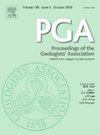Microbial mound origin for enigmatic, sea-floor, circular structures? Purbeck Limestone Group, offshore Dorset, U.K.
IF 1.2
4区 地球科学
Q2 Earth and Planetary Sciences
引用次数: 0
Abstract
This paper describes and interprets diver-collected, offshore samples to establish the origin of enigmatic large (100–200 m across) circular, dome-shaped features imaged using Multibeam Echo-Sounding (MBES) on the sea-floor of Weymouth Bay, Dorset, U.K. The structures occur within the Durlston Formation of the Purbeck Limestone Group (Late Jurassic–Early Cretaceous) that accumulated in a lagoon of variable salinity. A previous morphological study using MBES images alone led to four possible hypotheses for their origin; as isolated erosional remnants, as evaporite-related diapiric structures, as periclinal folds, or as eroded carbonate mounds that grew within the Purbeck lagoon. The petrographic study of seafloor samples taken from the centre of these structures results in their classification into nine sedimentary facies; eight limestones and one chert. The most abundant of these facies are similar to the well-known Purbeck limestones outcropping in nearby cliff sections, however four out of the nine facies have previously unrecorded microbialite components (intraclasts of travertine, stromatolites, laminated filamentous mudstones, and post-depositional, cavity-lining endostromatolites).
This petrographic analysis suggests a microbial carbonate mound origin for these structures that is also supported by their morphology, their restricted occurrence palaeogeographically and stratigraphically to within the Purbeck Limestone, and the occurrence of microbialites at this level in onshore outcrops. Carbonate mounds of this size, in a lagoonal setting, are previously unknown from the Wessex Basin but show some similarities with Early Cretaceous lacustrine build-ups in South Atlantic offshore basins. The work demonstrates how the interpretation of even an extremely well-known stratigraphy such as that of the Purbeck Group can be limited when only part of the marginal environment is exposed for study.
神秘的海底圆形结构的微生物丘起源?英国多塞特近海的Purbeck Limestone Group
本文描述并解释了潜水员收集的海上样本,以确定英国多塞特郡韦茅斯湾海底神秘的大型(100-200 m)圆形圆顶状特征的起源,该结构发生在Purbeck石灰岩群(晚侏罗世-早白垩世)的Durlston组中,该组沉积在盐度变化的泻湖中。先前仅使用MBES图像进行的形态学研究对其起源提出了四种可能的假设;如孤立的侵蚀残余物、与蒸发岩相关的底辟构造、斜周褶皱或生长在普贝克泻湖内的侵蚀碳酸盐丘。对这些构造中心的海底样品进行岩石学研究,将其划分为9个沉积相;八块石灰石和一块燧石。这些相中最丰富的是与附近悬崖剖面中露头的著名的Purbeck灰岩相似,然而,9个相中有4个具有以前未记录的微生物岩成分(钙华内碎屑、叠层石、层状丝状泥岩和沉积后的腔衬内叠层石)。岩石学分析表明,这些构造的微生物碳酸盐丘成因也得到了它们形态的支持,它们在古地理和地层上局限于Purbeck灰岩内,并且在这一水平上在陆上露头中存在微生物岩。在泻湖环境中,这种规模的碳酸盐丘以前在威塞克斯盆地中是未知的,但与南大西洋近海盆地的早白垩世湖泊堆积有一些相似之处。这项工作表明,当只有部分边缘环境被暴露出来进行研究时,即使是一个非常著名的地层学,如Purbeck组的地层学,也会受到限制。
本文章由计算机程序翻译,如有差异,请以英文原文为准。
求助全文
约1分钟内获得全文
求助全文
来源期刊
CiteScore
2.70
自引率
8.30%
发文量
54
审稿时长
6-12 weeks
期刊介绍:
The Proceedings of the Geologists'' Association is an international geoscience journal that was founded in 1859 and publishes research and review papers on all aspects of Earth Science. In particular, papers will focus on the geology of northwestern Europe and the Mediterranean, including both the onshore and offshore record. Following a long tradition, the PGA will focus on: i) a range of article types (see below) on topics of wide relevance to Earth Sciences ii) papers on aspects of Earth Science that have societal relevance including geoconservation and Earth management, iii) papers on palaeoenvironments and palaeontology of the Mesozoic and Cenozoic, iv) papers on aspects of Quaternary geology and climate change, and v) papers on the history of geology with particular reference to individuals that have shaped the subject. These topics will also steer the content of the themes of the Special Issues that are published in the PGA.

 求助内容:
求助内容: 应助结果提醒方式:
应助结果提醒方式:


